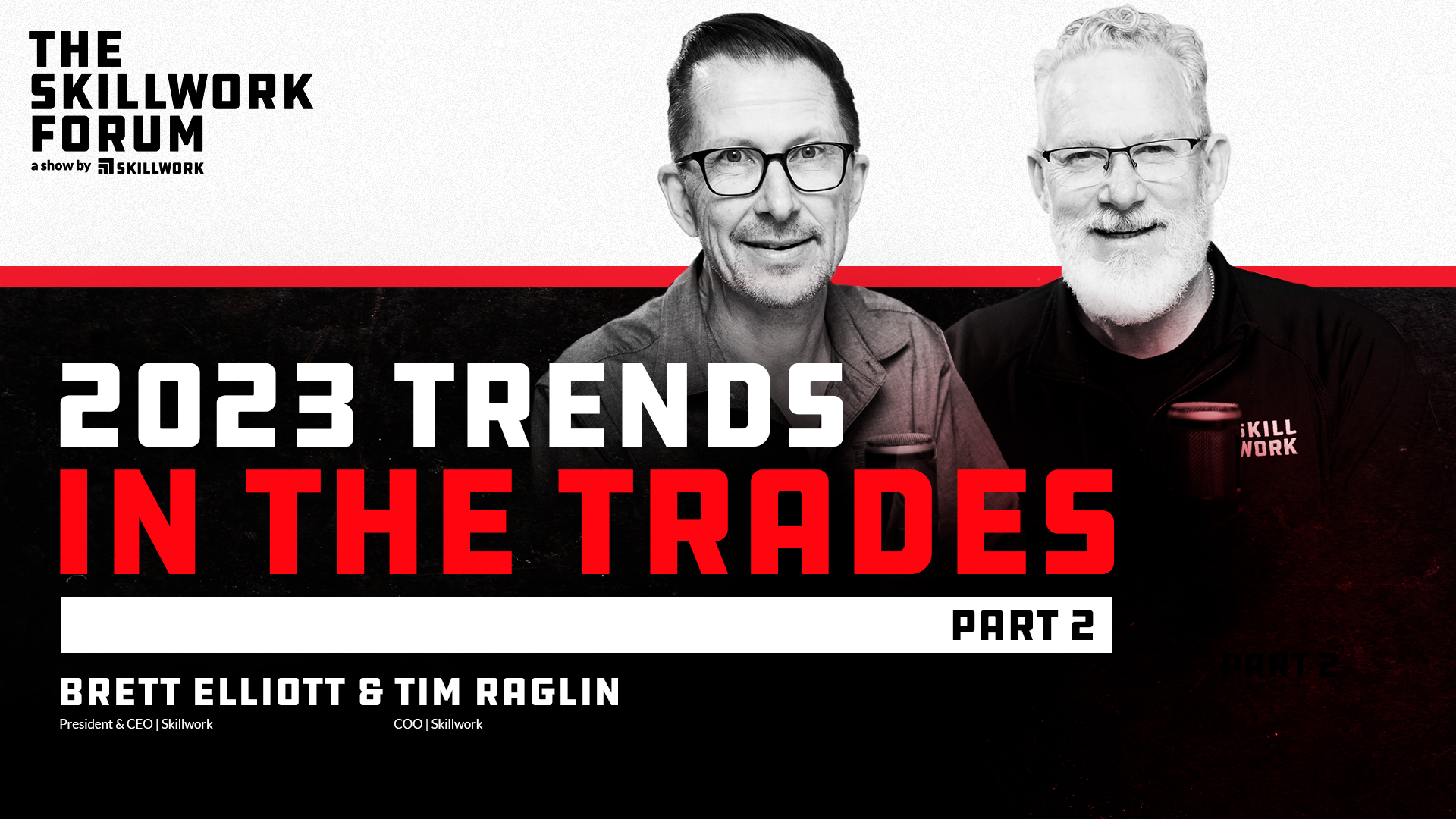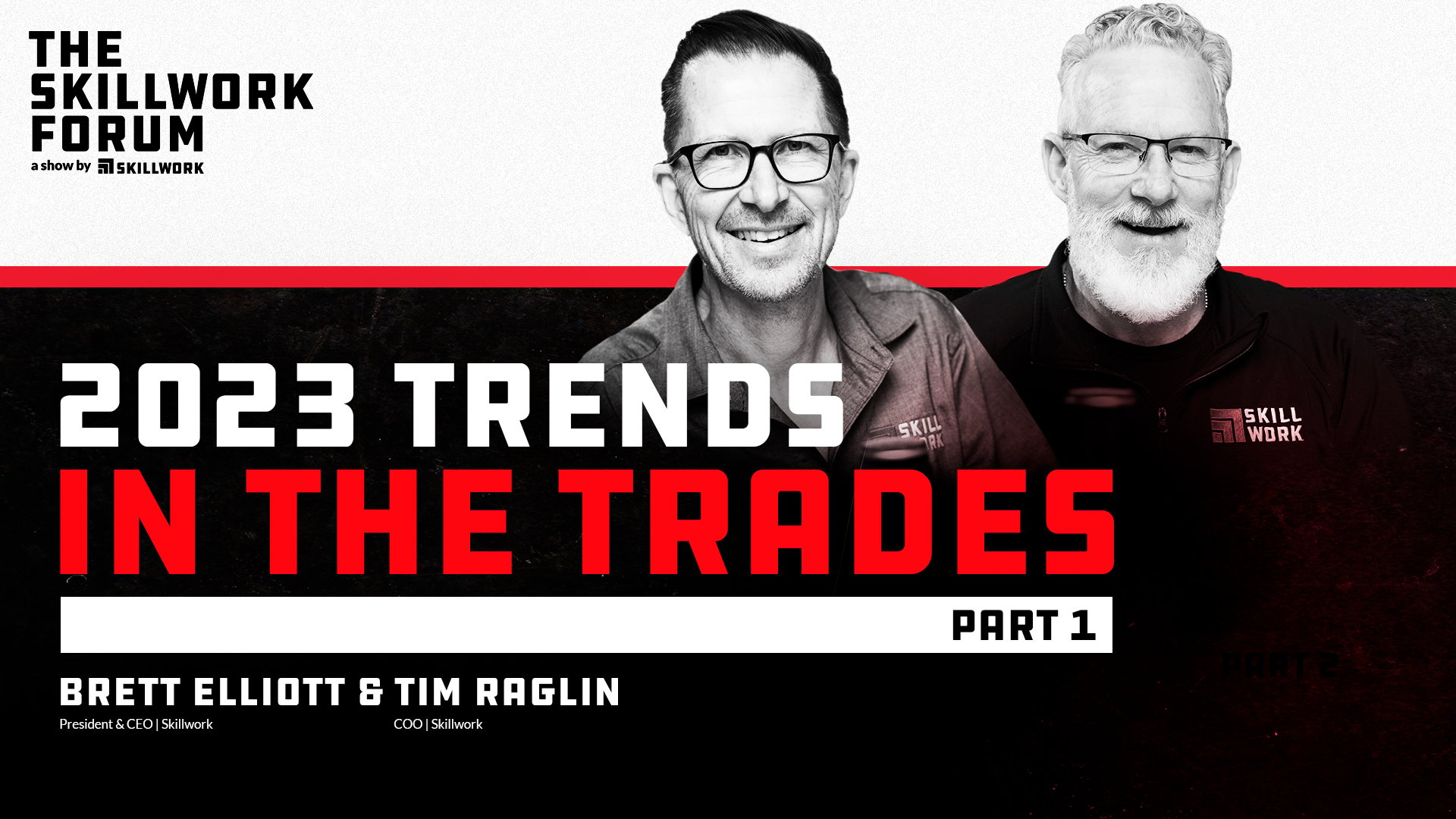2023 Future Labor Market Trends In the Trades [Part 2]

If you desire you can listen this episode on Spotify.
In part one of this two-part episode on 2023 skilled trade trends, we talked about the Great Resignation, the evolving workforce, the recession, inflationary pressures, how that will impact your business, and things you need to be on the lookout for as you head into 2023.
In this second part, we delve into other topics that we think will be big 2023 skilled trade trends. Advanced technology will be our first topic. We think it's also important to spend a little time talking about mental health and wellness – it's a new era for mental health at work.
Let’s jump into talking about our next trend, continuing last week’s list: smart factory technology.
Trend #5: Smart Factory Technology
Over the past year, we’ve spent a significant amount of time on this podcast talking about the fourth industrial revolution. It’s also known as “fourth IR,” but the term you hear a lot today is industry 4.0. So, that's what we're talking about—all the same thing—the digital transformation of business.
Deloitte’s 2023 manufacturing industry outlook reported 62% of executives said they’ll focus on robotics and automation over the next year. Implementing smart manufacturing technology is no longer something cool to do – it's a necessity.
What is a smart factory? Think of a smart factory and smart manufacturing as an electronic ecosystem. All your devices, machinery, production systems, supply, etc., are interconnected. The data you’re collecting is then used to inform decisions, improve your processes, predict how things will be impacted (e.g., maintenance failures), and be proactive to prevent issues before they arise.
This technological ecosystem is connecting the digital, the physical, and really the biological (meaning your people).
Cybersecurity
The other piece of this pie is cybersecurity.
Smart factory solutions are so dependent on technology that manufacturing facilities risk getting hacked. We were recently up in Chicago at the Rockwell Automation Fair, and it was amazing to see some of the advanced technology there. The most sophisticated booth that drew the largest crowd was the one promoting cybersecurity.
There are a lot of people out there trying to get your information or shut down your systems until you pay them a ransom, as we’ve seen happen time and time again. It can't be overstated: you need to invest in cybersecurity as you upgrade to industry 4.0.
Augmented Reality
Augmented reality (AR) is a form of technology being used to train and upskill technicians in simulated modules. For example, you can create a virtual reality (VR) where your workers are on a production floor and can assess the issues and choke points. It enables employers to start training workers before they ever touch the first piece of equipment.
Smart factory technology will predict potential maintenance breakdowns, while AR technology will allow you to simulate how to fix those issues. We're seeing more and more demand for higher levels of automation and people that can do that type of work.
The ability to train and upskill technicians will only become a more prevalent 2023 skilled trade trend, which we touch on later.
Trend #6: Hybrid Work Models
A McKinsey study recently reported that 58% of Americans work from home at least one day a week, and 38% were not required to be in the office at all. Obviously, skilled workers are a little different, but the majority of the U.S. workforce is working from home today. Likewise, a Workplace Intelligence article said among all full-time workers, it's estimated that around 15% are fully remote, 30% are on a hybrid arrangement, and the remaining 55% are fully on-site.
Hybrid flexible work has a lot to do with changing work dynamics, but it also has to do with how you're vetting, hiring, and managing your workforce. Start thinking about how you could provide flexible schedules, including four-day work weeks, and adapt to this changing work environment so you can attract applicants and retain existing employees.
_QG3.png?width=1080&height=1350&name=210505_Skillwork_TSWF_Ep_2023%20Trends%20(Part%202)_QG3.png)
Trend #7: Upskilling
According to a recent survey from Amazon and Workplace Intelligence, 83% of workers place improving their skills as their #1 priority in the coming year. The same study said 74% of employees are willing to leave their current job due to a lack of skill-building and career mobility options. People expect it, and they will leave if you're not doing it effectively for them.
Giving workers advanced capabilities is very attractive to them and will enhance your recruiting efforts. Additionally, supplementing your permanent workforce with a skilled support staff that has upskilled will be part of future trends in talent management.
At Skillwork, we offer upskilling opportunities to our skilled workers so they can evolve with industry 4.0. Trends in the future of work are leaning heavily towards technology, and we want our people to be equipped to work at digitally evolving companies like yours.
_QG1.png?width=1080&height=1350&name=210505_Skillwork_TSWF_Ep_2023%20Trends%20(Part%202)_QG1.png)
Trend #8: Mental Health in the Workplace
A third of employees surveyed (33%) said they sought mental health care in 2021. Some of that was due to isolation during the pandemic. All of a sudden, life itself was remote. So there is a negative side to being fully remote, which is why a hybrid work model is attractive.
One of the things that employees are looking for is any kind of company benefit where mental health and support are included. It’s important to become more aware of mental illness and empathetic toward some of the needs associated with it. You can’t ignore the level of burnout that is then leading to these mental health issues.
To prevent burnout, make sure you’re properly staffed. At Skillwork, we provide employers across the U.S. with skilled workers temporarily, allowing you to reach your goals, augment your staff, and give your workforce a little bit of relief. If there's a good opportunity for them to be a permanent hire for you, we provide that option as well.
Get in touch with a Skillwork recruiter to learn more.
Thanks very much for joining us for this two-part conversation about 2023 skilled trade trends. We hope they were valuable to you. We're looking at '23 with a lot of optimism, and we hope you are as well. Happy and prosperous new year to you!
_QG4.png?width=1080&height=1350&name=210505_Skillwork_TSWF_Ep_2023%20Trends%20(Part%202)_QG4.png)

_QG2.png?width=1080&height=1350&name=210505_Skillwork_TSWF_Ep_2023%20Trends%20(Part%202)_QG2.png)

